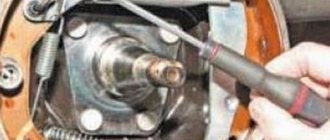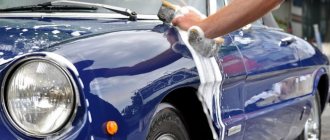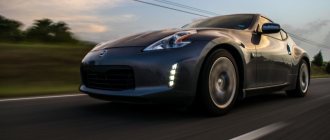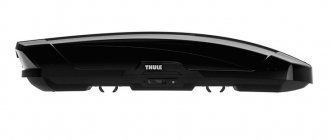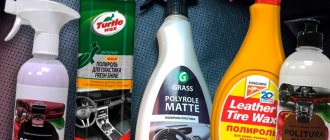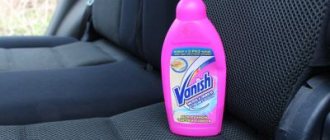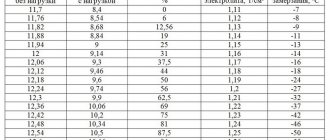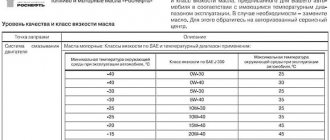Almost any car owner has encountered a situation where it is impossible to start a vehicle in winter - the starter will only crank the crankshaft several times, after which the car begins to quiet down. The problem here is usually a dead battery. There are several ways to recharge the battery in your car.
You can use a tug, push the car, or purchase special equipment for recharging. But all these methods require a lot of time to implement, and they will not always be effective.
The best option here is to connect to the electrical system of another vehicle. However, this requires special ignition wires.
The catch here is that now you can find a huge number of devices of this type on the market, so choosing a special set of cables is not so easy. We’ll talk now about what to pay attention to when choosing such wires.
Which parameters should you pay most attention to?
The only thing required of the starting wires is to transmit current from a charged battery to its own battery, which is discharged.
At the same time, it is important that the current losses are minimal (it is almost impossible to completely avoid them, so if the seller claims that this model does not have them, this is an outright lie).
For those who remember physics well, it is clear that the most important parameter here is resistance. The smaller it is, the more efficient the wiring will be. As a result, the potential difference at the end points of the connections will be minimal.
Thus, if you do not know how to choose wires for lighting, then you should pay attention to such parameters as:
- cross-sectional area (diameter);
- the material from which the wires are made;
- length of fixtures;
- quality of clamps.
Now we will look at these characteristics in more detail.
Starting current
The jumper cable used to light a vehicle can only successfully withstand a certain amount of electric current (amps) that passes through it. As a rule, most manufacturers indicate this parameter (maximum permissible current value) on their products.
In order to start a modern car model without problems, it is recommended to use starting wires with a minimum permissible starting current of 200 A. It is preferable for everyday use to purchase cables with a maximum permissible current of 400 A or more.
The ability of a wire to withstand a certain range of current is influenced by factors such as cross-sectional area, number, and diameter of the cores. Some manufacturers, to reduce the cost of their products, use a small number of thin-section cores. Such products are not able to withstand high inrush current. Therefore, when choosing a cable, it is also recommended to pay attention to the reputation of the manufacturer.
Length
First of all, you should pay attention to the length of the cable. Here it is necessary to take into account that the distance between vehicles can be quite significant. But this does not mean that you should only take the largest cable.
On the contrary, as the length increases, the voltage drop will increase. A meter wire differs in potential by 0.5 V. If you increase the length to 3 meters, then this parameter will reach 1.5 V (in the case of using two cables, the total losses will reach 3 V).
Thus, if 12 V comes from the donor battery, then only 9 V will reach your battery, as a result, the start-up will not always be successful (especially if there are certain problems with the power unit).
A cable with a long length is relevant only when the battery is by default located in the trunk or interior (yes, this also happens) of the vehicle.
At the same time, a terminal must be provided here that ensures the engine starts in emergency mode. It can be found mainly under the insulating gasket, which is bright red or bright orange. In this case, the cable should be 2-3.5 meters.
It is also worth remembering that if the car is in a garage, it is better to drive in backwards. If the battery runs out, you won't have to push the vehicle out.
Selection options
Some car owners are interested in the question of what the wires for lighting are called. That's what they're called - cigarette lighter wires. Today you can find many variations of car wires on sale, but in fact most of them cannot boast of high quality. In practice, cheap Chinese wires can fail after the first use.
Because of this, when purchasing, you should take into account certain parameters that will allow you to buy quality products:
- First, you must understand that the cost of high-quality and reliable cigarette lighter wires cannot be low. Good material, that is, the base from which the wires are made, is not cheap, and the crocodiles themselves are characterized by a rather complex design.
- Even if you choose expensive wires, this does not mean that the high price will guarantee the same quality. When choosing expensive products, carefully inspect the product when purchasing.
- When purchasing a finished product, pay attention first of all to the cable cross-section.
- If you see that there are inscriptions on the wires or clamps, but they are not legible and of poor quality, then most likely they were made in China. It is better to avoid purchasing such wires.
These are the basic rules that it is advisable to follow when purchasing, but not all consumers take them into account. If you want to purchase ready-made wires, then you need their technical characteristics to be slightly higher, this will ensure that you get the required product.
Before choosing a cable for lighting a car, read the list of requirements that such products must have:
- First, look at the length of the product you are purchasing. It should be at least one and a half meters, because if they are smaller, this will lead to the fact that the sides of the cars may touch during smoking. If the wire is too long, then there is a possibility that when lighting it, a loss of voltage will be observed. It is advisable that the wires be no shorter than two and no longer than four meters.
- As for the diameter of the purchased product, this parameter must be at least 0.6 cm. It is important that the cross-section for the wires varies around 0.9-1.2 cm. Despite the fact that the cost of such goods is higher, it is not recommended to save on their purchase. The cross section directly affects the strength of the transmitted current. So the thicker the cross-section, the stronger the current that passes through the cables.
- It is best that the crocodiles for the wires are made of copper; this option is considered the most optimal. There is no need to give preference to clamps made from cheaper materials. You can accurately understand that the cables are made of copper by their weight - copper crocodiles will be heavier.
- Pay attention to the starting current parameter - it needs to be at least 200 amperes. You also need to find out about other technical characteristics. According to experts, during lighting it will not be possible to avoid voltage leakage in any case. Therefore, it is advisable to select wires in which the voltage leakage will be no more than 2.3 volts with a wire length of 1.5 meters. In this case, the output voltage parameter must be at least 9 volts.
- Before purchasing, look at the connections, since they are considered one of the most vulnerable points; in this case, we are talking about the places where clamps and cables meet. The best option is for the wire to be securely soldered to the crocodile itself.
- As for the clamps themselves, they should have large areas, this will allow you to achieve the most optimal and high-quality contact. Also evaluate the strength of the alligator clip - it is important that the grip is not weak, since this way the clip will not be able to fix the terminal. It may seem that this point is not particularly important, but it is not. If the clamp comes off when lighting, it can lead to a short circuit and equipment failure.
- One of the most important points is the quality of cable insulation. In practice, most often the need to use wires for lighting occurs in the cold season, and at low temperatures, low-quality insulation can crack. Accordingly, this may cause current leakage and damage to the cable as a whole. The best option is for the insulation to be made of silicone rubber; this material is not afraid of low temperatures (video filmed by the Battery Manager channel).
Cross-sectional area
When choosing wires for lighting a car, you should also take a closer look at the diameter of the cable. Based on practice, the minimum diameter here reaches 5 mm (section 16 mm2).
In the case of devices with a smaller cross-section, the wires will overheat, which leads to a deterioration in current transmission.
It is worth noting that manufacturers quite often try to save on cables by making wiring with a small diameter, while covering it with a wide layer of insulating material. This is especially true for goods that are supplied to us from China.
You may also be interested in: Rear view mirror with monitor: which one would be best for a car?
Thus, you should not save money - it is better to choose a more expensive and reliable cable. By the way, domestic models are not too expensive, but they are very reliable and efficient, and also fully comply with the declared characteristics.
Diameter or cross-section of wires
This parameter is one of the most important when choosing cigarette lighters. On the market you can find products with wire cross-sections for lighting cars starting from 5 mm. up to 10 mm.
When deciding which wires to choose, you need to understand how the engine starts in such a situation. While the flywheel of the car engine is spinning, the starter requires about 200 A. In severe frosts, consumption doubles. Based on this, we can understand that in our situation we require conductors through which current will be carried with the lowest possible resistance. This result can be achieved using wires with cores having a diameter of 8-10 mm. If the core has a smaller diameter, the cigarette lighters can get very hot and consume more energy. Experts advise giving preference to the Russian manufacturer, since the Chinese one tries to save as much as possible and often hides a very small cross-section of wire behind thick insulation.
Material
Basically, stranded copper wire is used for the production of current conductors. At the same time, there are several features here, since copper from different manufacturers differs greatly in its qualities.
Lighting does not require a special quality of wire, so you can choose materials with a lower standard.
Purely theoretically, aluminum wiring can also be used, since it has reduced resistance. However, the material begins to melt at a relatively low temperature.
In addition, it is very fragile, so you should not use aluminum for cables. True, there are some very good models with an aluminum core, but this is the exception rather than the rule.
Almost any material is suitable for clamps. Including:
- copper;
- bronze;
- steel;
- brass, etc.
Preference should be given to brass and copper models. Bronze crocodiles are quite fragile, so they often break. Steel clamps in contact with copper lead to increased resistance.
In addition, as a result of this situation, a white or greenish coating will appear on them. At the same time, the cost of steel models is the lowest, which makes this option the most popular. Alternatively, steel clamps with teeth made of copper are used.
Soft polyvinyl chloride, which is more familiar to us under its abbreviation PVC, is suitable for insulation. It is difficult for an unprepared person to assess the quality of such material, which causes a number of difficulties.
First of all, you should pay attention to the operating temperatures of PVC. If the lower indicator is not too high, then when severe frosts set in, the material will begin to crack. Thus, operation of the cable will be impossible.
Budget options
AUTOVIRAZH AV-911200
They are distinguished by their low price, but quite decent quality. With their help, you can almost instantly start a car engine from the battery of another car, simply from a charged battery, or start it through a jump-start charger. The maximum starting current is 200 A. The length of the wires is significant - as much as 32 m. On the one hand, this is very convenient, because cars can be at a decent distance from each other, but the voltage losses are quite large.
More: Top 10 best towbars, how to choose the right towbar for a car?
The cables are supplied with a storage bag made of synthetic materials. This solution is very convenient - the wires will not be scattered throughout the trunk. The operating temperature of these wires ranges from -25 (at lower values the likelihood of damage to the wire insulation increases) to +60 degrees.
Advantages:
- The cable is flexible;
- The products are of decent length;
- The set includes a synthetic cover;
- Acceptable price.
Flaws:
- The wire is not very thick, so it cannot withstand too high a current.
Starting leads AUTOVIRAZH AV-911200
Airline SA-150-07S
The ends have very reliable and tight alligator clips. They come into the most intimate contact with the battery terminals and start the engine literally within one to two seconds. The length of the wires is only 2 meters, so the cars should be parked as close to each other as possible, the highest throughput current does not exceed 150 A, the cables are designed for a voltage of 12 V. The products are optimally suited for use in extremely cold winter conditions. The conductors are placed in frost-resistant insulation, which can withstand temperatures up to 40 degrees below zero.
The wires are made on the basis of copper stranded cores - there are as many as 80 of them in the structure. Their total cross-sectional area is 6.6 square meters. mm, which is a very serious parameter.
Advantages:
- Very high-quality cable insulation, which can easily withstand even quite severe frosts;
- The clamps are reliable, contact the terminals very tightly;
- Provides quick lighting.
Flaws:
- They are able to withstand low current, so such wires are suitable only for relatively weak engines.
Starting wires Airline SA-150-07S
AUTOSTART AS-P200-22
Although this product belongs to the budget price category, many users praise it in their reviews, since its quality and capabilities clearly exceed its cost. First of all, the wires are insulated from polyvinyl chloride materials with the addition of silicone. These substances can easily withstand very low temperatures (down to 50 degrees below zero) without deformation; cracks do not appear on the insulation even after several years. The conductive element consists of 80 copper strands that are intertwined.
Crocodiles are quite tight - in order to unclip them you will have to apply a decent amount of force. They fit securely to the battery terminals. The maximum starting current reaches 200 A, the cable is designed for 12 V, but the length is insignificant - only 2 m.
Advantages:
- Wire insulation can withstand severe frosts;
- Capable of passing optimal current through itself;
- The clamps are of high quality and connect tightly to the terminals.
Flaws:
- The length of the wires is short - you have to park the cars literally close to each other.
Jump leads AUTOSTART AS-P200-22
Airline SA-200-02
These wires are able to instantly start the engine regardless of weather conditions - they are designed for use at temperatures from -40 to +80 degrees. The starting current is 200 A. The terminals are compact in size, just like the conductive elements, they are made of high-quality copper - a material with minimal resistance to electricity. The small dimensions of the terminals help to get close to the battery, which is located in a hard-to-reach place under the hood of the car.
The operating voltage is quite standard - 12 V, the length of the wires is short (2 m). The set of wires comes in a reusable silicone case - it is convenient to store this product. The instructions are detailed and tell you in clear language how to use these cables correctly. The cross-section of the current-carrying conductors is 8.5 square meters. mm.
More: Top 10 best anti-freeze liquids for cars, how to choose anti-freeze liquid for a car?
Advantages:
- An excellent option for car engines whose volume does not exceed 2 liters;
- Crocodiles are made from high quality copper;
- The insulation is very soft and can easily withstand very low temperatures.
Flaws:
- The zipper on the case fails quite quickly;
- At maximum current, the wires heat up excessively, which ultimately leads to a voltage drop.
Starting wires Airline SA-200-02
How to avoid buying counterfeits
It's no secret that our market is now filled with a lot of counterfeit goods. Many wires lack descriptions and markings that allow one to evaluate the technical parameters of the device.
Such nameless cables have a suspiciously low cost, which may attract an inexperienced buyer. At the same time, you should not purchase such kits - when they are connected to a battery, there is a risk of fire.
Eliminating the consequences will cost you much more than the benefit from saving on the starting cable.
In addition, cheap Chinese goods from little-known brands are also not a very good option. Since you won’t take a caliper with you to the store, you won’t be able to check the cable diameter, and it’s also impossible to determine this by eye. As a result, you may buy too thin a wire.
It is better to buy products from domestic brands. They are usually of higher quality and also meet the specified parameters. And the difference in price is not too big to save that much. Either way, it never hurts to have a set of reliable starter wires in the glove compartment.
You may also be interested: Installing and connecting an on-board computer on a VAZ-2109
Step-by-step manufacturing instructions
Despite the wide variety of cables for lighting, it can often be difficult to find more or less high-quality products. Therefore, as a last resort, you can always build such wires with your own hands, and the procedure itself will not take much time and effort. To make the cable yourself, you will need the wire itself, its length should be from 4 to 8 meters, and the cable cross-section should be at least 9 mm. This is exactly the length you need, since the cable itself will have to be cut. If you take a cable with a cross-section of 10 mm or higher, it will be able to withstand even heavy loads.
It is also necessary that the cable you purchase has good insulation. As we said above, it is best that it is made of silicone frost-resistant rubber. An equally important point is the manufacture of connection clamps (alternatively, they can be removed from the car compressor).
If you buy crocodiles, it is advisable that they be welding - such devices have a strong body; in practice, welding clamps do not deform even after years of use. Also, such devices use a powerful spring, as a result of which the voltage drop, although there will be a minimum, is minimal. The welding clamps will need to be slightly modified, since they have a small contact area compared to the size of the battery terminals (video author - Evgeny Semenov).
The shape of the battery terminal is round and slightly elongated, so it is important that it matches the shape on the clamp. Otherwise, the crocodile will not be able to fully adhere to the terminal, and this will cause a loss of voltage; therefore, there will be no point in using a thick wire. When soldering, the ends of the wires should be slightly flattened, this way you can increase the contact area and reduce the likelihood of voltage loss. Alternatively, you can purchase ready-made clamps and improve them by installing copper plates on the crocodile, the thickness of which should be about 1.5-2 mm. These plates can be bent using pliers.
When the plates take the required shape, they will need to be fixed on clamps; rivets or stable bolts can be used for fastening. In order for the clamping efficiency to be as high as possible, the clamping components will need to be connected using AMG wire. At the final stage, the clamps are soldered to the cables; before performing this task, you need to apply tin to the soldered part. Then, using the soldering iron itself, the two components are connected - for better soldering, it is advisable to use a neutral flux, as well as refractory solder.
Photo gallery
Price issue
The cost of cigarette lighter wires depends on the manufacturer of the products, as well as their quality.
Average prices are:
- AIRLINE SA-400-01 cigarette lighter wires today cost about 950 rubles per set;
- a cheaper option - SKYWAY S03701005 - will cost approximately 550-600 rubles;
- powerful cigarette lighter wires CONTACT 600 Ah will cost the buyer approximately 1,300 rubles;
- AIRLINE EXPERT SA-1000-06E wires today cost at least 2,700 rubles.
How to light a car correctly
First of all, it is very important that the donor car is fully operational. Otherwise, a short circuit, fire and other unforeseen situations may occur. It is also very important that the on-board voltage in the cars matches (it can be 12 and 24 V).
First, we install the vehicles in such positions so that the terminals can be conveniently attached to the batteries of different vehicles. We turn off the cars and turn off all electrical appliances.
The order in which the terminals are connected is not critical; you just need to determine the polarity correctly (at the same time, for safety reasons, it is better to start with the negative terminal).
Below is a video with tips on choosing wires for “lighting up” a car:
Before starting work, be sure to wear protective gloves - you never know what can happen. Next, we check the quality of the wires for the presence of various mechanical damages. If certain defects are detected, lighting should not be performed.
We connect the red wire to the positive terminal, and connect the black or colorless wire to the negative terminal. We connect the plus to the plus of the discharged battery, install the black wire on any unpainted element of the second vehicle.
Next, we try to start the car with a discharged battery. If this does not work, we start the working car for 10-15 minutes.
We turn off the donor car and start our vehicle again. It is important to remember that you cannot start both cars at the same time, this can lead to a short circuit in the system.
If the car does not start, we try to recharge the battery for another 10 minutes with the donor starter turned on. There is no point in repeating the procedure more than 2 times. If lighting does not help, you will have to repair the vehicle.
Video “How to light a car yourself?”
How to light the battery of your car yourself from another car and avoid making mistakes - visual instructions are presented in the video below (the video was shot by Roman Kamaleev).
This is a simple device that helps you start the engine and continue on your way when your car battery is unable to turn the unit is called starting wires or cigarette lighter wires. The plus of one battery is connected to the plus of the other (red wire) and the minus to the minus (black wire)
They look like this -
And the process of “lighting up” is like this -
Yes, a charged battery is connected strictly according to polarity to a dead battery. For some time, a dead battery takes a charge from a charged one, and then, after starting the engine, it begins to charge from the generator. The cigarette lighter wires are disconnected and the car then operates autonomously.
There is another name for cigarette lighter wires. Experienced car enthusiasts sometimes call them “reins,” perhaps following the example of a pair of reins in a horse-drawn cart, which are used to spur a horse.
Starting wires (or, as they are also called, wires for “lighting up” a car) are usually used to supply starting current to the terminals of a discharged car battery. The source of current (in other words, the “donor”) in such cases, as a rule, is another car or a fully charged battery.
Most often, the need for cigarette lighter wires occurs at low air temperatures, as well as after long periods of parking the car, which cause self-discharge of the battery. But how to choose the right wires for lighting?
At the end of this article, watch a video with a test of starting “cigarette lighter wires”.
You may also be interested in the following materials on our website:
First, let's look at the basic characteristics that high-quality jumper wires should have.
DEKA
Very thick and very reliable cable. Great for large vehicles like a tractor or truck. The cable is very long - as much as 8 meters, so connecting the wire to the battery is not difficult. Only copper is used as wire, which is also a plus.
The throughput capacity reaches 600 A. The insulation is very reliable; it is made of thermoplastic elastomer, which is characterized by increased resistance to mechanical stress, temperature changes and aggressive environments. True, the price here is very high - about 9 thousand.
The ringleader
The product is produced in St. Petersburg. The cost is very low, about 3 hundred rubles. The declared current is very modest - only 220 A. However, in practice, even this figure is not achieved.
It is also worth highlighting the clearly poor contacts of this two-meter starter wire. Cold weather is tolerated quite well - perhaps the only advantage of the model.
Heyner
This German kit will cost about 4 thousand. At the same time, the quality here is appropriate. The model is characterized by increased wear resistance and resistance to low temperatures (even at -30 the cable can be used).
The length of the wire reaches 3.5-4.5 m. Everything is stored in a convenient fabric case equipped with a handle for transportation.
The cables are connected to the crocodiles using a threaded connection. The clamps are brass with a plastic coating. Each wire contains 320 copper cores, the total cross-section reaches 22.5 mm2.
Cigarette wire test
Imagine the situation: winter, frost, you go outside in the hope of getting to your destination in a warm car, get into it... but the starter does not respond to turning the ignition key or pressing a button - the battery is dead. And then you remember that you forgot to turn off the lights or, when getting out of the car, you sang along to your favorite song on the car radio, or the capacity of your battery has decreased over time to such an extent that the starter simply does not have enough strength in the cold.
What to do in this case? Pushing a car? Looking for a tug? Should I remove the battery and run to the nearest store in search of a charger? The easiest way is to find a luckier neighbor in the yard who has started his car and ask him to light a cigarette. But not a cigarette, of course... But to use his car as a source of energy in order to start your car. Starter cables, or, more simply put, cigarette lighter cables, are best suited for this purpose. Currently, there are a huge variety of types of cigarette lighter wires on the market with different current strengths and different price categories. We decided to test the cigarette lighter wires and took some of the most inexpensive ones, with the ability to transmit a current of 200 A.
So, let's look at the wires.
Tiikeri
Cost - 300 rubles
Production - China
The name evokes thoughts of cold, snowy Finland, but our northern neighbors have nothing to do with the production of these wires. Packed in a round bag with a zipper, there are additionally thin fabric gloves inside. The packaging indicates that frost-resistant materials down to -40 °C are used. The declared wire length of 2.5 meters corresponds to the actual one. The packaging also states that the wires are suitable for gasoline engines up to 1.6 liters and diesel engines up to 1.4 liters.
The positive and negative wires are connected together - the wire is two-core. The wire is connected to the crocodile by mechanical crimping. The handles of the “crocodiles” have insulating pads.
“Crocodiles” are steel, copper-plated.
The wire has 70 cores with a diameter of 0.3 mm, the cross-section of each core is 0.0706 square meters. mm. We multiply this value by the number of cores and get the total cross-section of each wire - 4.94 square meters. mm.
AVS
Cost - 380 rubles
Production - China
The wires are packed in a round bag with a zipper. There is a symbol on the packaging indicating that frost-resistant materials down to -40 °C are used. The declared wire length of 2.5 meters corresponds to the actual one. The packaging indicates that the wires are suitable for 2.5-liter gasoline engines and 2.2-liter diesel engines.
The positive and negative wires are separated. The wire is connected to the crocodile by double mechanical crimping. The wire braid has the AVS branding on it.
The “crocodiles” are made of steel, coated with copper; when the “jaws” are closed, they move laterally relative to each other - as a result, the “crocodile” does not get tooth on tooth when closing. The crocodile handles have insulating pads.
The packaging says that the wire uses 120 cores with a total cross-section of 9.6 square meters. mm, which was confirmed when they were counted. The diameter of the cores is 0.3 mm, the cross-section of one core is 0.0706 sq. m. mm, the total cross-section of all cores is only 8.5 square meters. mm.
Nova Bright
Cost - 300 rubles
Designed in the USA, Made in China
The wires are packed in a round bag with a zipper. The length of the wire is not indicated; when measuring, it turned out that these wires are only 2.2 meters long.
The positive and negative wires are separated, the wire winding is transparent. The wire is connected to the crocodile by double mechanical crimping.
“Crocodiles” are steel, copper-plated. The handles of the “crocodiles” have insulating pads.
Having opened the wire insulation, we counted only 60 cores with a diameter of 0.3 mm, each of them has a cross-section of 0.0706 square meters. mm. Thus, the total cross-section of all cores is 4.2 square meters. mm (the smallest wire cross-section of all those participating in the test).
ALCA
Cost - 570 rubles
Production - Germany
The wires are packed in a round bag with a zipper. The packaging contains a detailed instruction manual and step-by-step instructions for use. The actual wire length of 2.5 meters corresponds to that indicated on the packaging.
The positive and negative wires are separated. The wire is connected to the crocodile by double mechanical crimping. The wire braid bears the ALCA manufacturer's marking.
The “crocodiles” are plastic, with steel contacts coated with copper; the contacts are attached to the “crocodile” using rivets. The wire has 120 cores with a diameter of 0.3 mm, the cross-section of one core is 0.0706 square meters. mm. The total cross-section of all cores in the wire is 8.5 square meters. mm.
Heyner
Cost - 4000 rubles
Production - Germany
The wires are packed in a rectangular fabric bag with a zipper. The packaging states that the wires are frost-resistant down to -30 °C. The length is not specified, but measurements showed that the length of the wires with “crocodiles” is 3.5 meters - this is the longest of all those presented.
The positive and negative wires are made separately, but in the middle they are connected by a plastic box in which there is a surge suppressor. The wire is connected to the crocodile using a threaded connection. The wire braid is marked DIN 72553 25 mm2.
“Crocodiles” are massive cast brass, with a plastic coating; the “crocodiles” use double contact technology - a wire stretches from one “jaw” of the “crocodile” to the other, with its help both sides of the “crocodile” pass electric current - this increases the contact area and , accordingly, the ability to transmit more current through the “crocodiles”.
Each wire has 320 cores with a diameter of 0.3 mm, the cross-section of one core is 0.0706 square meters. mm, the total cross-section of all cores is 22.6 sq. mm (the largest wire cross-section of all presented).
AIRLINE
Cost - 400 rubles
Developed in St. Petersburg, manufactured in China
The wires are packed in plastic packaging with a top. The set comes with a fabric bag with a drawstring closure at the top. The packaging indicates that double contact technology is used, that is, current flows to both “jaws” of the “crocodile”, and there is also a sign indicating frost resistance at a temperature of -40 °C. When taking measurements, the actual length of the wire was 2 meters, which corresponds to the declared length. These are the shortest wires presented in the test.
The positive and negative wires are structurally made together. The wire is connected to the crocodile by mechanical crimping. The wire braid is marked AIRLINE SA-200-02 200A.
The “crocodiles” are plastic, with steel contacts coated with copper; the contacts are attached to the “crocodile” using rivets. The “crocodiles” - upon examination we were really convinced of this - use double contact technology, just like Heyner wires.
Each wire contains 120 cores with a diameter of 0.3 mm, the cross-section of one core is 0.0706 square meters. mm, the total cross-section of all cores is 8.5 sq. mm (ALCA and AVS have exactly the same wire cross-section).
Let's start testing.
First, we froze the wires for 24 hours at a temperature of -40 oC, then took them out and checked the insulation for fragility. To be honest, the results surprised us: in half of the cigarette lighter wires, the insulation loses its elasticity in the cold - and this is for something that is mainly used in winter!
When testing for frost resistance, the worst results were shown by wires under the American brand Nova Bright - the transparent insulation of these wires, when trying to straighten them out of the coil, began to crack and fly off in pieces. Perhaps the insulation of such wires is intended for hot California, but not for cold winter Russia.
Alca and Heyner wires also could not withstand freezing down to -40 °C - their insulation became brittle and cracked at the bends. However, it is worth noting that the manufacturer of Heyner wires warns in advance on the packaging that frost resistance is provided only down to -30 °C. When frozen to the specified temperature, the Heyner wires did not cause any complaints, and the external insulation retained its properties.
Tiikeri, AIRLINE and AVS wires can be safely bent - their insulation remains soft and flexible, despite the severe frost. However, these wires were indicated on the packaging that their insulation was made of frost-resistant material.
The next test was to test the wires while trying to create a 200 A load. In fact, the results of the second test are very predictable for those who know Ohm's law. After all, the larger the cross-section of the wire, the more it can pass through itself.
During load tests, the Nova Bright wires, due to their small cross-section, could not pass more than 100 A through themselves, while the voltage drop at the output was 6.2 V, that is, even if the voltage in the network of the “donor” car was 14.5 V, the discharged battery of the “recipient” car will receive only 8.3 V, which is clearly not enough for starting. In this case, the wires become very hot both themselves and at the points of connection with the “crocodiles”.
The Tiikeri wires, which performed so well in the cold, were also unable to pass the necessary current through themselves due to their small cross-section. The maximum that the ammeter showed was 120 A, while the voltage drop was 5 V, which also will not allow the car to start. The wires get very hot.
Due to their cross-section, the Heyner wires had a voltage drop of only 1 V - you can safely start the car without waiting for the battery of the “recipient” car to be recharged. The wires remain cold.
The ALCA and AVS wires showed the same result - the voltage drop was 3.6 V, which is on the verge of the starter starting to operate. In this case, the wires heat up at the junction with the “crocodiles”, and after a couple of seconds this place becomes hot. And on the ALCA wires, this connection even began to smoke.
The voltage drop on the AIRLINE wires under a load of 200 A was 3 V, while the wires remain cold, and the places where they connect to the “crocodiles” heat up a little - the additional wire has its effect on the second “jaw” of the “crocodiles”. You can start the car without waiting for the battery to recharge.
Result:
AVS and AIRLINE
Good frost resistance of the wires - even in severe frost, their insulation remains soft and flexible, although AIRLINE has a slightly lower voltage drop due to the double contact on the “crocodiles”. But they are also the shortest in the test, which can sometimes cause some inconvenience. Both wires will allow you to start the car without agonizing waiting in the cold.
Heyner
We really wanted to put Heyner wires first among all presented. They coped with their task of conducting current best of all thanks to the largest cross-section of the wire. Electrical contact is provided by both “jaws” of massive cast “crocodiles”, but the insulation has a frost resistance limit, which limits the use of wires in particularly cold regions. But they also offer to pay more for such wires than others.
ALCA
The insulation loses its elasticity in cold weather - with further use it can cause a short circuit. In addition, although they can pass a current of 200 A through themselves, at the same time strong heating occurs in the connection of the wire with the crocodile. The wires we tested emitted smoke from this connection.
Tiikeri
At least the manufacturer of these wires did not skimp on the wire insulation - it does not burst due to frost. But you won’t be able to start the car without agonizingly waiting in the cold.
Nova Bright
They absolutely cannot perform their function as wires for lighting - in cold weather the insulation cracks and crumbles, not to mention the fact that the wires are not able to pass a current of slightly more than 100 A through themselves.
How to “light” a car correctly
The positive terminal of the wire for lighting is red and is indicated by a “+” sign; accordingly, it must be connected to the “plus” on a discharged battery, and the other end of the wire must be connected to the positive terminal of a charged battery. The black wire is first connected to the negative terminal of the charged battery, which is indicated by the “-” sign, and it is recommended to connect the second end of the black wire to any unpainted part of the engine of the “recipient” car, otherwise the battery of the “donor” car may quickly discharge. Then we start the car with a charged battery and wait a few minutes (ideally 10-15). We turn off the engine, turn off the ignition and try to start the engine of the “lighted” car. If the battery is not charged enough, then it is better to pause for at least a minute and a half, and then let the engine of the “donor” car run for a few more minutes.
If the “lighting up” was successful, then we warm up the engine for several minutes without pressing the gas pedal, since due to an increase in the generator speed, a voltage surge may occur and the electronics may fail. Then we disconnect the wires for lighting in the reverse order, that is, first of all we remove the black wire from the engine. Next, we remove the “crocodiles” from the charged battery. There is also the option of “lighting” the car while the starting car’s engine is running, but in this case there may be undesirable consequences. It is possible that the generator may be overloaded or the electronics may fail. Therefore, the best option is to “light up” with the engine of the “donor” car turned off.
PS Frosts will soon begin in the main part of Russia, so prepare your car for winter in advance, check the condition of the battery, remember whether you poured (or added) water into the cooling system instead of antifreeze, and also replace the washer fluid in the washer reservoir with winter fluid.
And one more thing: for a more confident start of the engine in cold winters, before starting, let the battery warm up a little - flash the high beams several times or give it a small load in another way.
COLEMAN
A very good option for your money. The models are ideal for passenger vehicles as well as small trucks. Wires with a length of 4-8 meters are available to choose from; in addition, the diameter of the cable itself can vary.
If we talk about the operating temperature, it is very wide. The cable's flexibility is maintained even at minus 40 degrees Celsius.
You may also be interested in: The steering wheel hits when braking and while driving: causes and how to eliminate them
The clamps are quite ergonomic, and the wires can withstand heavy loads. Thanks to the polarity indicators, you will not connect the cable to the wrong terminal.
In addition, this is useful when performing work in the dark. The disadvantage is that aluminum is used for the core rather than copper.
ASTRO SMART PLU
A distinctive feature of the model is the safety clamps, thanks to which you will definitely not receive an electric shock in the event of polarity reversal or contact shorting. This not only makes the operation of the devices as safe as possible, but also prevents overloading the vehicle's electrical system.
Special LED indicators indicate whether you have connected the wires to the terminals correctly. The ends are connected separately, so that even if the cables touch, a short circuit will not occur.
The devices are capable of transmitting 400 A. The thickness reaches 6 millimeters, the length of the wire is 5.3 m. The service life reaches 10 years. This is not as much as in the case of conventional wires, but still quite good.
Airline
The model is produced in China, but the development was carried out by St. Petersburg engineers. At its very low cost, the starting device is characterized by excellent frost resistance (up to -40 degrees). The wire length is in the range of 2-5 m.
The cables are interconnected, which is an additional plus. The capacity in different models reaches from 200 to 400 A. The clamps are plastic, the contacts are made of steel. The crocodiles are made using dual contact technology, which is also good news. The total cable cross-section reaches 8.5 mm2.
Rating of the best starter cables in the mid-price segment
Alca
The product is manufactured by a German concern. Packaged in an attractive round zip pouch. The manufacturer provides instructions for use along with the product. The length of the accessory is 2.5 m. The wires with different poles are separated. Mechanical crimping is used to connect to plastic crocodiles. Number of cores – 120, cross-section – 0.0706 sq.mm.
The purchase price is 570 rubles.
Alca cigarette lighter wires
Advantages:
- German quality;
- quality factor;
- functionality;
- practicality;
- long service life.
Flaws:
- not identified.
Topauto Start 300 (27154/С)
Product from a domestic manufacturer. The two-meter product is reliable and durable. How many amps do the wires have? Only 2 A. Suitable for starting the engine with a weak battery. It is convenient to use at low temperatures due to the presence of thermoplastic handles. The maximum starting current is 300 A. The wires are made of copper. Everything is packed in a convenient case. Suitable for both passenger cars and trucks. Total weight – 700 g.
Purchase price – 593 rubles.
cigarette lighter wires Topauto Start 300 (27154/C)
Advantages:
- functionality;
- versatility;
- safety;
- positive reviews;
- reasonable cost;
- practicality.
Flaws:
- none.
Golden Snail 300 A/3 m (GS-9112)
The device is intended for passenger vehicles only. Able to help at temperatures from +50 to -40 degrees. Wire length – 3 meters. Copper clamps. Weight – 1 kg. Packed in a case for easy transportation and storage. The product is manufactured by an Austrian company. It’s difficult to call it a novelty, but it is still very popular among domestic motorists.
You will have to pay 662 rubles for the products.
cigarette lighter wires Golden Snail 300 A/3 m (GS-9112)
Advantages:
- ease of use;
- durability;
- reliability;
- build quality;
- strength.
Flaws:
- not always on sale.
Autovirazh AV/911400
The wires are rated at 400 A. Ideal for starting a dead battery. Withstands temperatures down to – 25 degrees below zero. Weight – 700 grams. Sold in packaging. Despite its Chinese origin, there were no complaints about the quality of the product. The set includes a convenient case.
The average cost is 649 rubles.
cigarette lighter wires Autovirazh AV/911400
Advantages:
- versatility;
- practicality;
- functionality;
- reliability.
Flaws:
- It will not work in severe frosts.
Skyway Standard, 400 A, S/03701010
Products of the Russian brand are manufactured at Chinese enterprises. Interesting type of cigarette lighter. It differs from its analogues in its ability to operate in a wide temperature range - from 80 degrees Celsius to 40 degrees Celsius. The maximum permissible starting current is 400 A. The clamps are made of PVC material, nickel-plated steel. The length of the product is 2.5 meters. The product weighs 980 grams. Sold with case. Convenient to transport and store. Sold in all specialized retail outlets.
The average price is 675 rubles.
wires for lighting Skyway Standard, 400 A, S/03701010
Advantages:
- reliability;
- functionality;
- build quality;
- value for money;
- positive reviews.
Flaws:
- none.
Runway (RR300)
An excellent device for starting an engine. Produced by a Russian company. Suitable for passenger vehicles. Copper wires. Operating temperature range: from +50 to -40 degrees. Allowable current – 300 A. Product length 2.5 m. Packed in a case. Weight – 1.3 kg. The design belongs to the frost-resistant category. Contacts are of high quality. The insulation materials are top notch.
The average cost is 626 rubles.
Runway cigarette lighter wires (RR300)
Advantages:
- ease of use;
- quality of materials used;
- practicality;
- reliability;
- long service life.
Flaws:
- not identified.
DolleX 300/A (PS/300)
The products are manufactured by a domestic enterprise. Quality is controlled at every stage of production. Almost no defects go on sale. The product is very popular among motorists. The length of the accessory is 2.5 meters. Suitable for charging batteries with low power up to 75 A/h. Effective insulation was achieved due to the presence of a dense and high-quality outer braid. Regardless of weather conditions, it will not lose its original characteristics for a long time, will not tear or fall apart. Copper cables, two in number, with different polarities. Weight – 1.1 kg. Packaging: convenient case.
The purchase price is 732 rubles.
cigarette lighter cables DolleX 300/A (PS/300)
Advantages:
- core cross-section – 0.3 mm;
- 140 cores in the wire;
- cable diameter – 8.5 mm;
- reliability;
- safety;
- practicality;
- wear resistance;
- durability.
Flaws:
- none.
Nova Bright
American starting device, made in China. A budget model, the length of which is in the optimal range: 1.5-2.5 m. The wires are made separately, transparent plastic is used as insulation.
The clamps are connected to the cable using double crimping. The crocodiles themselves are made of copper-plated steel. The total cross-section reaches 4.2 mm2, which, in principle, is quite small. True, even with these indicators the cable demonstrates good characteristics.
No one knows when it will be necessary to light a car battery. So, it never hurts to have a quality jump starter in your glove compartment. At the moment there is a fairly large selection of devices of this type.
At the same time, it is very important to choose models with high-quality markings from trusted manufacturers. Otherwise, you risk getting caught by a fake.
The following is a video about wires for lighting, which are on sale and which are better to buy:
Alligator clips
The main working part in the starting wires are special gear-type grips, which car enthusiasts often call “crocodiles”. Thanks to these grips, you can quickly connect to the battery terminals (observing polarity). When choosing crocodiles, it is recommended to pay attention to such nuances as:
- The material from which the product is made. In the manufacture of the grip, as a rule, copper is used. There are also specimens made from combined compounds, equipped with teeth made of copper. It is not recommended to purchase teeth coated with a thin layer of copper plating and made from different metals.
- Gripability. It is recommended to buy teeth with a large gripping area (contact).
- Connecting the cable to the clamp handle. It is best to buy models in which the wire is connected to the crocodile by soldering.
In addition, when purchasing crocodiles, you should pay attention to the presence of high-quality insulation. It is preferable to buy teeth equipped with rubber seals. Such seals reduce heat and prevent sparks from occurring when the wire is subjected to increased loads.
